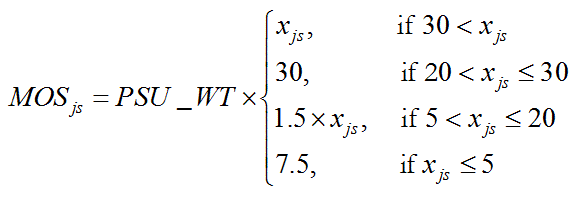- Surveys & Programs
- Data & Tools
- Fast Facts
- News & Events
- Publications & Products
- About Us
NAEP Technical DocumentationComputation of Measures of Size for the 2011 Public School Writing Computer-Based Assessment (WCBA)
In the design of each school sample, five objectives underlie the process of determining the probability of selection for each school and how many students are to be sampled from each selected school containing grade-eligible students:
- to meet the target student sample size;
- to select an equal-probability sample of students;
- to limit the number of students who are selected from a school;
- to ensure that the sample within a school does not include a very high percentage of the students in the school, unless all students are included; and
- to reduce the rate of sampling of small schools, in recognition of the greater cost and burden per student of conducting assessments in such schools.
The goal in determining the school's measure of size is to optimize across the last four objectives in terms of maintaining the accuracy of estimates and the cost-effectiveness of the sample design. The following algorithm was used to assign a measure of size to each school based on its estimated grade enrollment as indicated on the sampling frame.
The measures of size vary by enrollment size. The initial measures of size (MOS) were set as follows, for both eighth and twelfth grades:
where xjs is the estimated grade enrollment for grade j (j = 8, 12) in school s, and PSU_WTS is the primary sampling unit (PSU) weight for school j.
An adjustment to the initial measure of size was made for some schools. Schools with a high percentage of Black or Hispanic students, and schools in the PSU containing Honolulu County, had their measure of size increased by a factor of two, in order to double their probability of selection.
The rescaled measure of size, Ejs, was defined as:
A final adjustment was made to the measures of size (Ejs) in the national sample to attempt to reduce school burden by minimizing the number of schools selected for simultaneous administration of both the state and national studies. The NAEP 2011 studies used an adaptation of the Keyfitz process to compute conditional measures of size that, by their design, minimized the number of schools selected for the national study (WCBA) that were also selected for the state assessment or the Trends in International Mathematics and Science Study (TIMSS).
The school's probability of selection πjs was given by:
One can choose a value of bj such that the expected overall student sample yield matches the desired targets specified by the design, where the expected yield is calculated by summing the product of an individual school’s probability and its student sample yield across all schools in the frame.
In addition, new and newly eligible schools were sampled from the new-school frame. The assigned measures of size for these schools,
used the bj value from the main school sample for the grade (i.e., the same sampling rates as for the main school sample). The variable πdjs is the probability of selection of the district into the new-school district (d) sample.
Last updated 26 February 2016 (GF)
